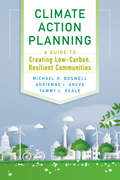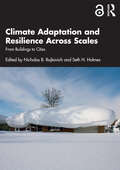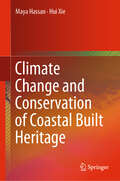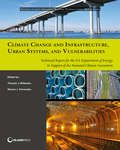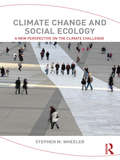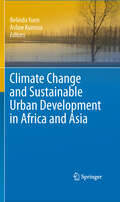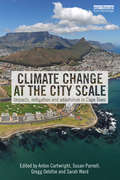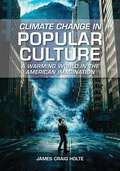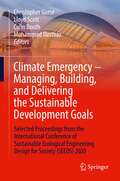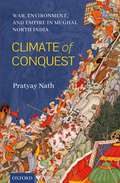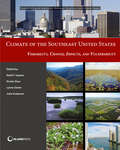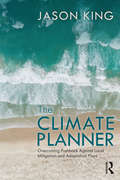- Table View
- List View
Climate Action Planning: A Guide to Creating Low-Carbon, Resilient Communities
by Michael R Boswell Adrienne I. Greve Tammy L. SealeClimate Action Planning is designed to help professionals working at local levels to develop and implement plans to mitigate a community's greenhouse gas emissions and increase the resilience of communities against climate change impacts. This fully revised and expanded edition goes well beyond climate action plans to examine the mix of policy and planning instruments available to every community. Climate Action Planning brings in new examples of implemented projects to highlight what has worked and the challenges that remain. A completely new chapter on vulnerability assessment will help each community to identify their greatest risks and opportunities. Sections on land use and transportation have been expanded to reflect their growing contribution to greenhouse gas emissions. The guidance in the book is put in context of international, national, and state mandates and goals. Climate Action Planning is the most comprehensive book on the state of the art, science, and practice of local climate action planning. It should be a first stop for any local government interested in addressing climate change.
Climate Adaptability of Buildings: Bioclimatic Design in the Light of Climate Change
by Mitja KoširThis book examines bioclimatic design with a focus on the application of climate adaptability in the design of future buildings and renovation of existing energy-efficient buildings. It addresses the challenge of how to construct and renovate buildings so that they maintain desired performance even as the climate changes in future decades. The book is divided into six chapters that guide the reader from basic concepts to discussions on specific aspects of bioclimatic design, including: Why do we construct buildings and why do they matter?Where should we get started with bioclimatic design?The opportunities and potential held by climate for the by bioclimatic architecture and design.How and why should we design bioclimatic buildings to accommodate future climatic conditions?Climatic changes and implications for the bioclimatic design of buildings. The author presents an overview of effective bioclimatic design strategies that enable climate-adaptable buildings. He also addresses the problems of designing with climate, which are relevant for all types of building design—in particular, the implications for bioclimatic buildings that are intrinsically connected to the climate they were adapted to. The book combines representative examples, diagrams, and illustrations, and concludes each chapter by reviewing the most important findings and concepts discussed. The book offers a valuable source of information for researchers and architectural engineers, who will gain essential insights into the process of using the available tools and data to design buildings that can respond to future climate challenges, as well as a general introduction into the field of bioclimatic building design. The book will also be of interest to graduate students and architects, as it approaches bioclimatic design with a particular focus on the analytical design process for such buildings.
Climate Adaptation and Resilience Across Scales: From Buildings to Cities
by Nicholas B. RajkovichClimate Adaptation and Resilience Across Scales provides professionals with guidance on adapting the built environment to a changing climate. This edited volume brings together practitioners and researchers to discuss climate-related resilience from the building to the city scale. This book highlights North American cases that deal with issues such as climate projections, public health, adaptive capacity of vulnerable populations, and design interventions for floodplains, making the content applicable to many locations around the world. The contributors in this book discuss topics ranging from how built environment professionals respond to a changing climate, to how the building stock may need to adapt to climate change, to how resilience is currently being addressed in the design, construction, and operations communities. The purpose of this book is to provide a better understanding of climate change impacts, vulnerability, and resilience across scales of the built environment. Architects, urban designers, planners, landscape architects, and engineers will find this a useful resource for adapting buildings and cities to a changing climate.
Climate Adaptation and Resilience Across Scales: From Buildings to Cities
by Nicholas B. Rajkovich Seth H. HolmesClimate Adaptation and Resilience Across Scales provides professionals with guidance on adapting the built environment to a changing climate. This edited volume brings together practitioners and researchers to discuss climate-related resilience from the building to the city scale. This book highlights North American cases that deal with issues such as climate projections, public health, adaptive capacity of vulnerable populations, and design interventions for floodplains, making the content applicable to many locations around the world. The contributors in this book discuss topics ranging from how built environment professionals respond to a changing climate, to how the building stock may need to adapt to climate change, to how resilience is currently being addressed in the design, construction, and operations communities. The purpose of this book is to provide a better understanding of climate change impacts, vulnerability, and resilience across scales of the built environment. Architects, urban designers, planners, landscape architects, and engineers will find this a useful resource for adapting buildings and cities to a changing climate.
Climate Adaptation in Urban Planning: Toward Sustainable and Resilient Urban Environments (SpringerBriefs in Architectural Design and Technology)
by Simona MannucciThis book provides an overview of the current planning paradigms and technical strategies to cope with climate change, specifically flooding. Architecture and planning face the challenging task of designing the built environment while addressing complex issues in urban areas. Factors such as climate change, societal and economic issues and population growth can significantly impact the success of a plan. In order to plan for the future, adaptation and flexibility have become crucial. However, the traditional deterministic approach in planning allows no room for failure, expecting plans and projects to achieve desired objectives regardless of how the future unfolds. It also explores new planning paradigms, methods, and tools from other disciplines that can be integrated into urban planning to achieve long-term, flexible adaptation in the face of uncertain conditions (Decision Making Under Deep Uncertainty—DMDU). Additionally, a case study is presented, focusing on addressing uncertainties in a flood-prone area in Rome through scenario planning, combining various cutting-edge model-based methodologies drawn from DMDU. The target audiences are researchers and practitioners in architecture and urban planning.
Climate Change and Conservation of Coastal Built Heritage
by Maya Hassan Hui XieThis book presents the preservation principles and the current environmental challenges relating to monitoring heritage sites and buildings under the effects of climate change. It provides a clear overview of conservation action levels and the importance of participation and cooperation between them, and discusses evaluation and management methods, thermal comfort for the common usages, and conceptual methods for enhancing the built heritage. The research presented employed the “Zoom In, Zoom Out” approach for monitoring the Syrian coastal heritage sites threatened by the direct and indirect effects of climate change. Lastly, the book establishes the basic principles and conservation strategies for preserving the coastal heritage sites and buildings. As such, it is a valuable reference resource for researchers, developers, architects, and conservators involved in protecting the architectural heritage in coastal areas. It can also be used as a guidebook on preserving and monitoring built heritage sites at both macro and micro levels.
Climate Change and Cooling Cities (Urban Sustainability)
by Ali Cheshmehzangi Bao-Jie He Ayyoob Sharifi Andreas MatzarakisThis edited book provides a solid foundation for future research on cooling cities, climate change impacts on cities and urban environments, and innovative mitigation and adaptation strategies. With ever-increasing climate change impacts on our living environments and continuous calamities and natural disasters around the world, we urge for new approaches, apt action, and adequate support to boost cooling strategies for the built environments. To achieve this goal, research, practice, and policy could do much more to provide us with new pathways to achieve sustainable development. This book is a comprehensive collection of theoretical perspectives and global case study examples focused on three core areas of (1) concepts, theories, and trends, (2) mitigation and adaptation strategies, and (3) policies. The book is of use to various stakeholders and more importantly to urban specialists, planners and designers, policymakers, academics, practitioners, and developers. We urge them to mitigate climate change before it gets too late. We are confident the book could provide readers with new ideas, strategies, and directions that could lighten up the path toward new actions, policies, and innovation.
Climate Change and Infrastructure, Urban Systems, and Vulnerabilities: Technical Report for the U.S. Department of Energy in Support of the National Climate Assessment (NCA Regional Input Reports)
by Thomas J. Wilbanks and Steven FernandezHurricane Irene ruptured a Baltimore sewer main, resulting in 100 million gallons of raw sewage flooding the local watershed. Levee failures during Hurricane Katrina resulted in massive flooding which did not recede for months. With temperatures becoming more extreme, and storms increasing in magnitude, American infrastructure and risk-management policies require close examination in order to decrease the damage wrought by natural disasters. Climate Change and Infrastructure, Urban Systems, and Vulnerabilities addresses these needs by examining how climate change affects urban buildings and communities, and determining which regions are the most vulnerable to environmental disaster. It looks at key elements of urban systems, including transportation, communication, drainage, and energy, in order to better understand the damages caused by climate change and extreme weather. How can urban systems become more resilient? How can citizens protect their cities from damage, and more easily rebound from destructive storms? This report not only breaks new ground as a component of climate change vulnerability and impact assessments but also highlights critical research gaps in the material. Implications of climate change are examined by assessing historical experience as well as simulating future conditions.Developed to inform the 3rd National Climate Assessment, and a landmark study in terms of its breadth and depth of coverage and conducted under the auspices of the U.S. Department of Energy, Climate Change and Infrastructure, Urban Systems, and Vulnerabilities examines the known effects and relationships of climate change variables on American infrastructure and risk-management policies. Its rich science and case studies will enable policymakers, urban planners, and stakeholders to develop a long-term, self-sustained assessment capacity and more effective risk-management strategies.
Climate Change and Museum Futures (Routledge Research in Museum Studies)
by Fiona Cameron Brett NeilsonClimate change is a complex and dynamic environmental, cultural and political phenomenon that is reshaping our relationship to nature. Climate change is a global force, with global impacts. Viable solutions on what to do must involve dialogues and decision-making with many agencies, stakeholder groups and communities crossing all sectors and scales. Current policy approaches are inadequate and finding a consensus on how to reduce levels of greenhouse gases in the atmosphere through international protocols has proven difficult. Gaps between science and society limit government and industry capacity to engage with communities to broker innovative solutions to climate change. Drawing on leading-edge research and creative programming initiatives, this collection details the important roles and agencies that cultural institutions (in particular, natural history and science museums and science centres) can play within these gaps as resources, catalysts and change agents in climate change debates and decision-making processes; as unique public and trans-national spaces where diverse stakeholders, government and communities can meet; where knowledge can be mediated, competing discourses and agendas tabled and debated; and where both individual and collective action might be activated.
Climate Change and Museum Futures (Routledge Research in Museum Studies)
by Fiona R. Cameron Brett NeilsonClimate change is a complex and dynamic environmental, cultural and political phenomenon that is reshaping our relationship to nature. Climate change is a global force, with global impacts. Viable solutions on what to do must involve dialogues and decision-making with many agencies, stakeholder groups and communities crossing all sectors and scales. Current policy approaches are inadequate and finding a consensus on how to reduce levels of greenhouse gases in the atmosphere through international protocols has proven difficult. Gaps between science and society limit government and industry capacity to engage with communities to broker innovative solutions to climate change. Drawing on leading-edge research and creative programming initiatives, this collection details the important roles and agencies that cultural institutions (in particular, natural history and science museums and science centres) can play within these gaps as resources, catalysts and change agents in climate change debates and decision-making processes; as unique public and trans-national spaces where diverse stakeholders, government and communities can meet; where knowledge can be mediated, competing discourses and agendas tabled and debated; and where both individual and collective action might be activated.
Climate Change and Social Ecology: A New Perspective on the Climate Challenge
by Stephen M. WheelerAlthough strategies to prevent global warming – such as by conserving energy, relying on solar and wind power, and reducing motor vehicle use – are well-known, societies have proved unable to implement these measures with the necessary speed. They have also been unwilling to confront underlying issues such as overconsumption, overpopulation, inequity, and dysfunctional political systems. Political and social obstacles have prevented the adoption of improved technologies, which would provide only a partial solution in any case if the fundamental causes of greenhouse gas emissions aren’t addressed. Climate Change and Social Ecology takes a new approach to the climate crisis, portraying global warming as a challenge of rapid social evolution. This book argues that, in order to address this impending catastrophe and bring about more sustainable development, we must focus on improving social ecology – our values, mind-sets, and social organization. Steps to do this include institutional reforms to improve democracy, educational strategies to encourage public understanding of complex issues, and measures to prevent corporations and the wealthy from shaping societies in other directions instead. This book presents a captivating vision of how to help social systems evolve toward sustainability and explores the social transformations needed for dealing with the climate crisis in the long term. It reviews the climate change strategies considered to date, presents a detailed description of a future sustainable society, and analyzes how this vision might be realized through more conscious public nurturing of our social systems. This interdisciplinary volume provides a compelling rethink of the climate crisis. Authoritative and accessible, it will be of great interest to anyone concerned about climate change and sustainability challenges and is essential reading for students, professionals, and general readers alike.
Climate Change and Social Ecology: A New Perspective on the Climate Challenge
by Stephen M. WheelerAlthough strategies to prevent global warming – such as by conserving energy, relying on solar and wind power, and reducing motor vehicle use – are well-known, societies have proved unable to implement these measures with the necessary speed. They have also been unwilling to confront underlying issues such as overconsumption, overpopulation, inequity, and dysfunctional political systems. Political and social obstacles have prevented the adoption of improved technologies, which would provide only a partial solution in any case if the fundamental causes of greenhouse gas emissions aren’t addressed. Climate Change and Social Ecology takes a new approach to the climate crisis, portraying global warming as a challenge of rapid social evolution. This book argues that, in order to address this impending catastrophe and bring about more sustainable development, we must focus on improving social ecology – our values, mind-sets, and social organization. Steps to do this include institutional reforms to improve democracy, educational strategies to encourage public understanding of complex issues, and measures to prevent corporations and the wealthy from shaping societies in other directions instead. This book presents a captivating vision of how to help social systems evolve toward sustainability and explores the social transformations needed for dealing with the climate crisis in the long term. It reviews the climate change strategies considered to date, presents a detailed description of a future sustainable society, and analyzes how this vision might be realized through more conscious public nurturing of our social systems. This interdisciplinary volume provides a compelling rethink of the climate crisis. Authoritative and accessible, it will be of great interest to anyone concerned about climate change and sustainability challenges and is essential reading for students, professionals, and general readers alike.
Climate Change and Sustainable Urban Development in Africa and Asia
by Belinda Yuen and Asfaw KumssaThis book is about African and Asian cities. Illustrated through selected case cities, the book brings together a rich collection of papers by leading scholars and practitioners in Africa and Asia to offer empirical analysis and up-to-date discussions and assessments of the urban challenges and solutions for their cities. A number of key topics concerning housing, sustainable urban development and climate change in Africa and Asia are explored along with how policy interventions and partnerships deliver specific forms of urban development. It is intended for all who are interested in the state of the cities and urban development in Africa and Asia. Africa and Asia present, in many ways, useful lessons in dealing with the burgeoning urban population, and the problems surrounding this influx of people and climate change in the developing word.
Climate Change at the City Scale: Impacts, Mitigation and Adaptation in Cape Town
by Anton Cartwright Susan Parnell Gregg Oelofse Sarah WardClimate change impacts are scale and context specific, and cities are likely to bear some of the greatest costs. In recent years cities have begun to craft their own climate change responses against the backdrop of the reluctance displayed by nation-states in committing to emissions reductions and managing the consequences of climate change. Climate Change at the City Scale presents a fresh contribution to climate change literature, which has largely neglected the role of cities in spite of their increasingly important role in the global economy. The book focuses on the impacts of climate change in the rapidly evolving city of Cape Town, and captures the experiences of the Cape Town Climate Change Think Tank, a hybrid knowledge partnership which has produced research on a range of urban governance, impacts, mitigation and adaptation challenges by the City. Cape Town has long been acknowledged as an innovator in the area of urban environmental management, notwithstanding its limited resources to manage the demand for a more resilient and equitable future. By documenting the work and experiences of the City’s efforts to define its own climate future, the book provides a provocative case study of the way in which the science-policy interface can be managed to inform urban transformation.
Climate Change at the City Scale: Impacts, Mitigation and Adaptation in Cape Town
by Anton Cartwright Susan Parnell Gregg Oelofse Sarah WardClimate change impacts are scale and context specific, and cities are likely to bear some of the greatest costs. In recent years cities have begun to craft their own climate change responses against the backdrop of the reluctance displayed by nation-states in committing to emissions reductions and managing the consequences of climate change. Climate Change at the City Scale presents a fresh contribution to climate change literature, which has largely neglected the role of cities in spite of their increasingly important role in the global economy. The book focuses on the impacts of climate change in the rapidly evolving city of Cape Town, and captures the experiences of the Cape Town Climate Change Think Tank, a hybrid knowledge partnership which has produced research on a range of urban governance, impacts, mitigation and adaptation challenges by the City. Cape Town has long been acknowledged as an innovator in the area of urban environmental management, notwithstanding its limited resources to manage the demand for a more resilient and equitable future. By documenting the work and experiences of the City’s efforts to define its own climate future, the book provides a provocative case study of the way in which the science-policy interface can be managed to inform urban transformation.
Climate Change, Hazards and Adaptation Options: Handling the Impacts of a Changing Climate (Climate Change Management)
by Walter Leal Filho Gustavo J. Nagy Marco Borga Pastor David Chávez Muñoz Artur MagnuszewskiThis book addresses the issue of climate change risks and hazards holistically. Climate change adaptation aims at managing climate risks and hazards to an acceptable level, taking advantage of any positive opportunities that may arise. At the same time, developing suitable responses to hazards for communities and users of climate services is important in ensuring the success of adaptation measures. But despite this, knowledge about adaptation options, including possible actions that can be implemented to improve adaptation and reduce the impacts of climate change hazards, is still limited. Addressing this need, the book presents studies and research findings and offers a catalogue of potential adaptation options that can be explored. It also includes case studies providing illustrative and inspiring examples of how we can adapt to a changing climate.
Climate Change in Popular Culture: A Warming World in the American Imagination
by James Craig HolteAn invaluable resource for general readers investigating climate change, this book examines the impact of climate change on popular culture and analyzes how writers and directors treat the disasters caused by climate change in their novels and films.Climate Change in Popular Culture: A Warming World in the American Imagination is the first study that includes analyses of both fiction and popular nonfiction works devoted to climate change. In addition, the book examines a number of classic works from the perspective of the growing field of climate change literature and includes a brief history of climate change science as well basic scientific definitions, all intended for general readers.The text provides an introduction to the science, politics, and economics of climate change. It also includes both historical overviews and potential probable futures projected by leading climate scientists and environmental writers. In addition, the text looks at how such creative writers and directors as Margaret Atwood, John Steinbeck, Paulo Bacigalupi, Kim Stanley Robinson, T. C. Boyle, Michael Crichton, and Octavia Butler, among others, have used the disasters caused by climate change in their work.
Climate Change in Popular Culture: A Warming World in the American Imagination
by James Craig HolteAn invaluable resource for general readers investigating climate change, this book examines the impact of climate change on popular culture and analyzes how writers and directors treat the disasters caused by climate change in their novels and films.Climate Change in Popular Culture: A Warming World in the American Imagination is the first study that includes analyses of both fiction and popular nonfiction works devoted to climate change. In addition, the book examines a number of classic works from the perspective of the growing field of climate change literature and includes a brief history of climate change science as well basic scientific definitions, all intended for general readers.The text provides an introduction to the science, politics, and economics of climate change. It also includes both historical overviews and potential probable futures projected by leading climate scientists and environmental writers. In addition, the text looks at how such creative writers and directors as Margaret Atwood, John Steinbeck, Paulo Bacigalupi, Kim Stanley Robinson, T. C. Boyle, Michael Crichton, and Octavia Butler, among others, have used the disasters caused by climate change in their work.
The Climate City
by Martin PowellTHE CLIMATE CITY Provides professionals in finance, technology, and consulting with solutions for improving the quality of urban life under the changing climate The Climate City provides cutting-edge approaches for developing resilient solutions to combat the effects of climate change in cities throughout the world. Linking finance and technology to policy and innovation, this highly practical resource outlines a global framework for mitigating and adapting to climate change and for effectively planning and delivering a low-carbon future. This book addresses how cities can work effectively with each other to drive change, the importance of strong leadership and international cooperation, the role of innovative finance and technology to identify new economic opportunities, and more. Throughout the book, the authors address future trends such as the changing streetscape, connected infrastructure and eMobility, and autonomous vehicles, drones, and other emerging technologies. Designed to help all stakeholders build a pathway to a less resource-intensive future, The Climate City: Provides in-depth discussion of the technological, financial, and practical aspects of tackling climate change in urban environments Demonstrates why the global economy needs to transition to a low-carbon economy Describes the role of financial institutions and how they can allocate capital more efficiently Explains why and how challenges and priorities are different in the global north and south Illustrates how data can improve the ways cities use energy resources and operate transportation systems Discusses how citizen action can drive a new, more meaningful way of living in cities Features insights from political leaders such as the Mayor of Copenhagen, the Mayor of Los Angeles and the former Mayor of London and Prime Minister of the United Kingdom The Climate City is essential reading for city planners, policy makers, technologists, consultants, finance and business professionals, and general readers wanting to improve the cities in which they work and live.
The Climate City
by Martin PowellTHE CLIMATE CITY Provides professionals in finance, technology, and consulting with solutions for improving the quality of urban life under the changing climate The Climate City provides cutting-edge approaches for developing resilient solutions to combat the effects of climate change in cities throughout the world. Linking finance and technology to policy and innovation, this highly practical resource outlines a global framework for mitigating and adapting to climate change and for effectively planning and delivering a low-carbon future. This book addresses how cities can work effectively with each other to drive change, the importance of strong leadership and international cooperation, the role of innovative finance and technology to identify new economic opportunities, and more. Throughout the book, the authors address future trends such as the changing streetscape, connected infrastructure and eMobility, and autonomous vehicles, drones, and other emerging technologies. Designed to help all stakeholders build a pathway to a less resource-intensive future, The Climate City: Provides in-depth discussion of the technological, financial, and practical aspects of tackling climate change in urban environments Demonstrates why the global economy needs to transition to a low-carbon economy Describes the role of financial institutions and how they can allocate capital more efficiently Explains why and how challenges and priorities are different in the global north and south Illustrates how data can improve the ways cities use energy resources and operate transportation systems Discusses how citizen action can drive a new, more meaningful way of living in cities Features insights from political leaders such as the Mayor of Copenhagen, the Mayor of Los Angeles and the former Mayor of London and Prime Minister of the United Kingdom The Climate City is essential reading for city planners, policy makers, technologists, consultants, finance and business professionals, and general readers wanting to improve the cities in which they work and live.
Climate Disaster Preparedness: Reimagining Extreme Events through Art and Technology (Arts, Research, Innovation and Society)
by Michael J. Ostwald Ursula Frohne Dennis Del Favero Susanne ThurowAs a result of global warming, extreme events, such as firestorms and flash floods, pose increasingly unpredictable and uncertain existential threats, taking lives, destroying communities, and wreaking havoc on habitats. Current aesthetic, technological and scientific frameworks struggle to imagine, visualise and rehearse human interactions with these events, hampering the development of proactive foresight, readiness and response.This open access book demonstrates how the latest advances in creative arts, intelligent systems and climate science can be integrated and leveraged to transform the visualisation of extreme event scenarios. It reframes current practice from passive perception of pre-scripted illustrations to active immersion in evolving life-like interactive scenarios that are geo-located. Drawing on the multidisciplinary expertise of leaders in the creative arts, climate sciences, environmental engineering, and intelligent systems, this book examines the waysin which climate disaster preparedness can be reformulated through practices that address dynamic and unforeseen interactions between climate and human life worlds. Grouped into four sections (picturing, narrating, rehearsing, and communicating), this book maps this approach by exploring the emerging strengths and current limitations of each discipline in addressing the challenge of envisioning the unpredictable interaction of extreme events with human populations and environments. This book provides a timely intervention into the global discourse on how art, culture and technology can address climate disaster resilience. It appeals to readers from multiple fields, offering academic, industry and community audiences novel insights into a profound gap in the current knowledge, policy and action landscape.
Climate Emergency – Managing, Building , and Delivering the Sustainable Development Goals: Selected Proceedings from the International Conference of Sustainable Ecological Engineering Design for Society (SEEDS) 2020
by Christopher Gorse Lloyd Scott Colin Booth Mohammad DastbazThrough research and proven practice, the aim of the International Conference of Sustainable Ecological Engineering Design for Society (SEEDS) is to foster ideas on how to reduce negative impacts on the environment while providing for the health and well-being of society. The professions and fields of research required to ensure buildings meet user demands and provide healthy enclosures are many and diverse. The SEEDS conference addresses the interdependence of people, the built and natural environments, and recognizes the interdisciplinary and international themes necessary to assemble the knowledge required for positive change.
Climate of Conquest: War, Environment, and Empire in Mughal North India
by Pratyay NathWhat can war tell us about empire? In Climate of Conquest, Pratyay Nath seeks to answer this question by focusing on the Mughals. He goes beyond the traditional way of studying war in terms of battles and technologies. Instead, he unravels the deep connections that the processes of war-making shared with the society, culture, environment, and politics of early modern South Asia. Climate of Conquest closely studies the dynamics of the military campaigns that helped the Mughals conquer North India and project their power beyond it. The author argues that the diverse natural environment of South Asia deeply shaped Mughal military techniques and the course of imperial expansion. He also sheds light on the world of military logistics, labour, animals, and the organization of war; the process of the formation of imperial frontiers; and the empire’s legitimization of war and conquest. What emerges is a fresh interpretation of Mughal empire-building as a highly adaptive, flexible, and accommodative process.
Climate of the Southeast United States: Variability, Change, Impacts, and Vulnerability (NCA Regional Input Reports)
by Keith T. Ingram, Kirstin Dow, Lynne Carter and Julie AndersonPrepared for the 2013 National Climate Assessment and a landmark study in terms of its breadth and depth of coverage, Climate of the Southeast United States is the result of a collaboration among three Regional Integrated Sciences and Assessments Centers: the Southeast Climate Consortium; the Carolinas Regional Sciences and Assessments and the Southern Climate Impacts Planning Program; with contributions from numerous local, state, federal and nongovernmental agencies to develop a comprehensive, state of the art look at the effects of climate change in the region.
The Climate Planner: Overcoming Pushback Against Local Mitigation and Adaptation Plans
by Jason KingThe Climate Planner is about overcoming the objections to climate change mitigation and adaption that urban planners face at a local level. It shows how to draft climate plans that encounter less resistance because they involve the public, stakeholders, and decisionmakers in a way that builds trust, creates consensus, and leads to implementation. Although focused on the local level, this book discusses climate basics such as carbon dioxide levels in the atmosphere, the Intergovernmental Panel on Climate Change, the Paris Agreement of 2015, worldwide energy generation forecasts, and other items of global concern in order to familiarize urban planners and citizen planners with key concepts that they will need to know in order to be able to host climate conversations at the local level. The many case studies from around the United States of America show how communities have encountered pushback and bridged the implementation gap, the gap between plan and reality, thanks to a commitment to substantive public engagement. The book is written for urban planners, local activists, journalists, elected or appointed representatives, and the average citizen worried about climate breakdown and interested in working to reshape the built environment.
